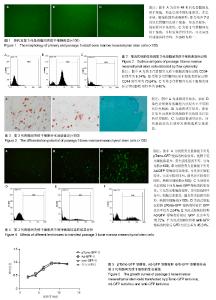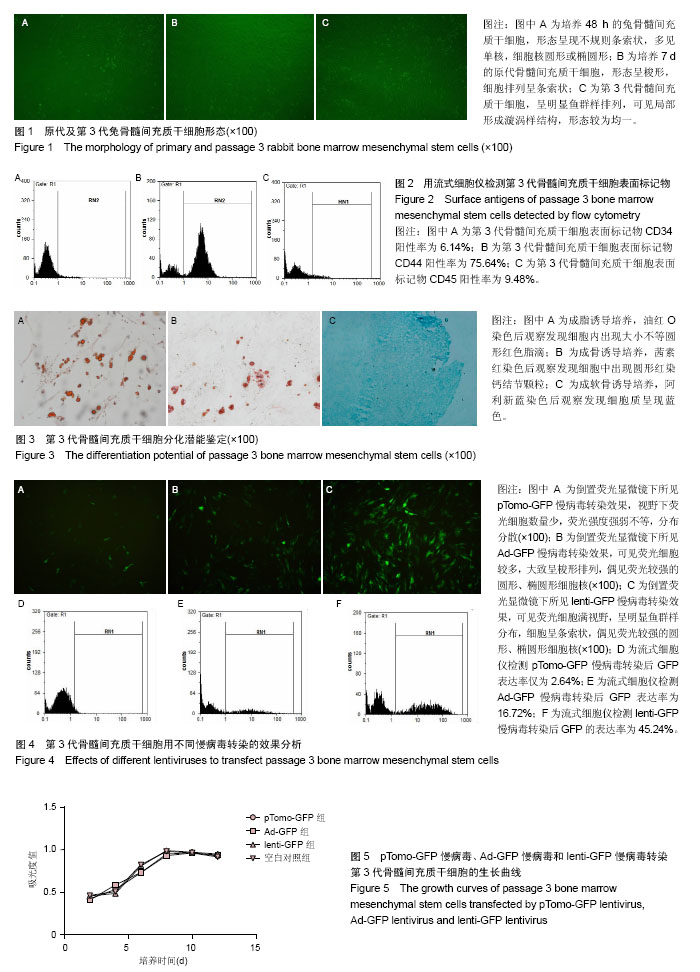| [1] Xu R, Xu J, Liu W. Study on the differentiation of human mesenchymal stem cells into vascular endothelial-like cells. Sheng Wu Yi Xue Gong Cheng Xue Za Zhi. 2014;31(2): 389-393.[2] 王慧建,李彦林,陈建明,等, TGF-β3基因转染诱导滇南小耳猪BMSCs向软骨分化的初步研究[J].中国修复重建外科杂志, 2014, 28(2):149-154.[3] Huang B, Tabata Y, Gao JQ. Mesenchymal stem cells as therapeutic agents and potential targeted gene delivery vehicle for brain diseases. J Control Release. 2012;162(2): 464-473.[4] Galbraith DW, Anderson MT, Herzenberg LA. Flow cytometric analysis and FACS sorting of cells based on GFP accumulation. Methods Cell Biol. 1999;58:315-341.[5] Kim YG, Park B, Ahn JO, et al. New cell line development for antibody-producing Chinese hamster ovary cells using split green fluorescent protein. BMC Biotechnol. 2012;12:24.[6] 中华人民共和国科学技术部.关于善待实验动物的指导性意见. 2006-09-30.[7] Shao J, Zhang W, Yang T. Using mesenchymal stem cells as a therapy for bone regeneration and repairing. Biol Res. 2015;48: 62.[8] Mostafa NZ, Uluda? H, Varkey M, et al. In vitro osteogenic induction of human gingival fibroblasts for bone regeneration. Open Dent J. 2011;5:139-145.[9] Lopes JP, Fiarresga A, Silva Cunha P, et al. Mesenchymal stem cell therapy in heart disease. Rev Port Cardiol. 2013; 32(1): 43-47.[10] Nurkovic J, Dolicanin Z, Mustafic F, et al. Mesenchymal stem cells in regenerative rehabilitation. J Phys Ther Sci. 2016; 28(6):1943-1948.[11] Horn P, Bork S, Wagner W. Standardized isolation of human mesenchymal stromal cells with red blood cell lysis. Methods Mol Biol. 2011;698:23-35.[12] 武海军,银和平,李树文,等.密度梯度离心和贴壁筛选法分离培养兔骨髓间充质干细胞的形态学观察[J].中华临床医师杂志:电子版, 2012,6(22):7261-7265.[13] Horn P, Bork S, Diehlmann A, et al. Isolation of human mesenchymal stromal cells is more efficient by red blood cell lysis. Cytotherapy. 2008;10(7):676-685.[14] Gubin AN, Reddy B, Njoroge JM, et al. Long-term, stable expression of green fluorescent protein in mammalian cells. Biochem Biophys Res Commun. 1997;236(2):347-350.[15] Li X, Luo Q, Sun J, et al. Conditioned medium from mesenchymal stem cells enhances the migration of hepatoma cells through CXCR4 up-regulation and F-actin remodeling. Biotechnol Lett. 2015;37(3):511-521.[16] 贾莹,陈波.两种不同方法分离、培养大鼠骨髓基质干细胞的比较研究[J].贵州医药, 2005, 29(10): 893-895.[17] 王亦菁,张晓东,孙淏海,等.免疫磁珠筛选大鼠牙髓干细胞、外胚间充质干细胞的表型研究[J].口腔医学,2014,34(6):454-456.[18] Gang EJ, Hong SH, Jeong JA, et al. In vitro mesengenic potential of human umbilical cord blood-derived mesenchymal stem cells. Biochem Biophys Res Commun. 2004;321(1):102-108.[19] Dominici M, Le Blanc K, Mueller I, et al. Minimal criteria for defining multipotent mesenchymal stromal cells. The International Society for Cellular Therapy position statement. Cytotherapy. 2006;8(4):315-317.[20] 易敏,付必莽,李志伟,等.兔骨髓间充质干细胞的培养及初步鉴定[J].昆明医科大学学报, 2015, 36(9):17-19.[21] Rastegar F, Shenaq D, Huang J, et al. Mesenchymal stem cells: Molecular characteristics and clinical applications. World J Stem Cells. 2010;2(4):67-80.[22] 阮征,王莲芳,胡修忠,等.新生猪骨髓间充质干细胞衍生细胞的分离、培养及生物学特性分析[J].生物技术通报, 2015(6): 170-176.[23] 李静,张仁东.骨髓间充质干细胞研究进展[J].四川解剖学杂志, 2014, 22(1): 38-40.[24] Platzbecker U, Ehninger G, Bornhäuser M. Allogeneic transplantation of CD34+ selected hematopoietic cells--clinical problems and current challenges. Leuk Lymphoma. 2004;45(3): 447-453.[25] van Galen P, Kreso A, Mbong N, et al. The unfolded protein response governs integrity of the haematopoietic stem-cell pool during stress. Nature. 2014;510(7504):268-272.[26] Kronenwett R, Martin S, Haas R. The role of cytokines and adhesion molecules for mobilization of peripheral blood stem cells. Stem Cells. 2000;18(5):320-330.[27] Zhu H, Mitsuhashi N, Klein A,et al. The role of the hyaluronan receptor CD44 in mesenchymal stem cell migration in the extracellular matrix. Stem Cells. 2006;24(4):928-935.[28] de Bruijn MF, Ma X, Robin C, et al. Hematopoietic stem cells localize to the endothelial cell layer in the midgestation mouse aorta. Immunity. 2002;16(5):673-683.[29] 赵玉鑫,王福科,李彦林,等.Brdu标记VECs和ADSCs构建组织工程骨体内增殖研究[J].昆明医科大学学报, 2014, 35(3): 13-18.[30] Zhou HX, Liu ZG, Liu XJ, et al. Umbilical cord-derived mesenchymal stem cell transplantation combined with hyperbaric oxygen treatment for repair of traumatic brain injury. Neural Regen Res. 2016;11(1):107-113.[31] Maklakova IY, Grebnev YD, Yastrebov AP. The influence of extreme factors on homing multipotent mesenchymal stromal cells. Patol Fiziol Eksp Ter. 2015;59(4):82-86.[32] 王鑫,李彦林,金耀峰,等. BMP-2、TGF-β3重组腺病毒载体的构建及其在滇南小耳猪BMSCs中的表达[J].中国修复重建外科杂志, 2014, 28(7): 896-902.[33] Doi K, Nibu K, Ishida H, et al. Adenovirus-mediated gene transfer in olfactory epithelium and olfactory bulb: a long-term study. Ann Otol Rhinol Laryngol. 2005;114(8):629-633. |



